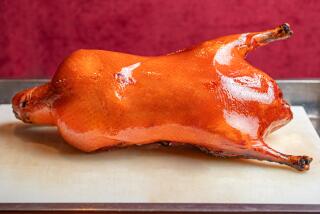Pour on the duck fat, in moderation
- Share via
Love fries but hate the thought of artery-clogging fried food?
A growing number of gourmet restaurants and foodies see a solution to this conundrum in an unlikely source — duck fat. They consider it a healthy alternative to frying foods in pork fat, beef fat or even butter. Duck fat is high in beneficial unsaturated fats, and its chemical composition is closer to olive oil than to butter, they say.
Plus, it’s delicious. “I love it,” said David Bazirgan, executive chef at the Fifth Floor restaurant in San Francisco. “It has a deep, rich flavor that coats the palate.”
But some experts say health claims about the fat are overstated. Though duck fat is among the healthiest of animal fats, it’s still a significant source of saturated fats, said Dr. Freny Mody, director of cardiology for the Greater Los Angeles Veterans Affairs Healthcare System.
“It may be a peg closer to olive oil, but it’s still miles away,” Mody said.
Duck fat’s popularity has surged in part because consumers are seeking all-natural, locally sourced alternatives to commercially produced items, said Melissa Abbott, culinary insights director with the Hartman Group, a Seattle-area market research firm. Compared with, say, margarine, duck fat has a single, minimally processed ingredient: fat taken from ducks. It’s available from local butchers and at farmers markets, though a few national retailers sell it as well.
Abbott said the fat had also gained some cachet thanks to the so-called French paradox — the observation that the French are thinner and have a lower incidence of cardiovascular disease than Americans despite enjoying a diet loaded in fat. The paradox has stumped researchers for decades, though some theories chalk it up to a number of characteristics of the French diet — including small portions, lots of red wine, and, of course, the consumption of duck fat.
While traditional French recipes can call for copious amounts of the fat (duck confit, for instance, involves cooking duck legs immersed in duck fat for 10 hours), the current vogue in the U.S. is to use it in more sparing amounts to make fries, to roast potatoes or to saute vegetables. Chefs treasure its dense, savory flavor and its resistance to breaking down at high temperatures. They also like that it’s a healthful fat, Abbott said.
That belief is based on its composition of saturated and unsaturated fats. According to the National Nutrient Database maintained by the U.S. Department of Agriculture, duck fat contains 62% unsaturated fat and 33% saturated fat.
Saturated fats raise blood cholesterol and increase the risk of heart disease, said Dr. Karol Watson, co-director of the UCLA Cholesterol and Lipid Management Center. At 33%, duck fat’s saturated fat content isn’t terribly low, she points out. In fact, it’s on par with chicken fat (about 30% saturated fat) and pork fat (39% saturated fat). All three are better than butter, which is about 51% saturated fat.
Proponents of duck fat prefer to highlight its unsaturated fat content. Studies have linked unsaturated fats — including both monounsaturated and polyunsaturated fats — to lower blood cholesterol levels. Dutch researchers who reviewed 60 studies of the effects of dietary fat intake found that replacing saturated fats with unsaturated fats reduced levels of bad cholesterol and raised levels of good cholesterol, which in turn decreased the incidence of coronary artery disease by 18% to 44%. Their findings were published in the American Journal of Clinical Nutrition in 2003.
Duck fat enthusiasts are particularly keen on its levels of a monounsaturated fat called oleic acid, which olive oil has in abundance. Some research indicates oleic acid may be behind the beneficial effects of the Mediterranean diet. Many large studies have indicated that the Mediterranean diet — in which olive oil is the predominant source of fat — can lower the risk of heart disease, cancer and other diseases of aging.
But although 40% of duck fat is oleic acid, its content doesn’t quite compare with that of olive oil, which is 71% oleic acid, according to a 2007 analysis by University of Wisconsin researchers published in the Journal of Food Quality.
And just because duck fat contains oleic acid — or even a decent amount of unsaturated fats in general — that doesn’t override the fact that one-third of duck fat is unhealthy saturated fat, Watson said.
And both saturated and unsaturated fats get incorporated into cell walls, where they affect the elasticity of the vascular system, Watson added. That’s why the American Heart Assn. stresses that unsaturated fats are beneficial only when they take the place of saturated fat in the diet, Mody said.
All in all, she said, cooking with duck fat may be preferable to cooking with butter, pork fat or beef fat (which contains 50% saturated fat). But it’s still nowhere near as healthful as cooking with olive oil or other vegetable oils, such as safflower oil and canola oil. According to the USDA, olive oil contains less than 14% saturated fat, while canola and safflower oil contain less than 8%.
Which means that when it comes to using duck fat, “it’s not an everyday alternative — not by a long shot,” Mody said.
That is something most duck fat aficionados already know, thanks to the fat’s price tag. An 11.2-ounce jar costs $10.95 at Williams-Sonoma; Costco sells a package of four 12-ounce tubs for $32.99.
“Use it in place of butter or lard if it really, really tastes wonderful,” Mody said. “But maybe just twice a year.”





